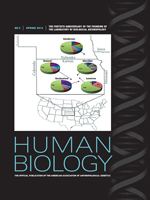Maya civilization developed in Mesoamerica and encompassed the Yucatan Peninsula, Guatemala, Belize, part of the Mexican states of Tabasco and Chiapas, and the western parts of Honduras and El Salvador. This civilization persisted approximately 3,000 years and was one of the most advanced of its time, possessing the only known full writing system at the time, as well as art, sophisticated architecture, and mathematical and astronomical systems. This civilization reached the apex of its power and influence during the Preclassic period, from 2000 BCE to 250 CE. Genetic variation in the pre-Hispanic Mayas from archaeological sites in the Mexican states of Yucatan, Chiapas, Quintana Roo, and Tabasco and their relationship with the contemporary communities in these regions have not been previously studied. Consequently, the principal aim of this study was to determine mitochondrial DNA (mtDNA) variation in the pre-Hispanic Maya population and to assess the relationship of these individuals with contemporary Mesoamerican Maya and populations from Asia, Beringia, and North, Central, and South America. Our results revealed interactions and gene flow between populations in the different archaeological sites assessed in this study. The mtDNA haplogroup frequency in the pre-Hispanic Maya population (60.53%, 34.21%, and 5.26% for haplogroups A, C, and D, respectively) was similar to that of most Mexican and Guatemalan Maya populations, with haplogroup A exhibiting the highest frequency. Haplogroup B most likely arrived independently and mixed with populations carrying haplogroups A and C based on its absence in the pre-Hispanic Mexican Maya populations and low frequencies in most Mexican and Guatemalan Maya populations, although this also may be due to drift. Maya and Ciboneys sharing haplotype H10 belonged to haplogroup C1 and haplotype H4 of haplogroup D, suggesting shared regional haplotypes. This may indicate a shared genetic ancestry, suggesting more regional interaction between populations in the circum-Caribbean region than previously demonstrated. Haplotype sharing between the pre-Hispanic Maya and the indigenous populations from Asia, the Aleutian Islands, and North, Central, and South America provides evidence for gene flow from the ancestral Amerindian population of the pre-Hispanic Maya to Central and South America.
How to translate text using browser tools
1 April 2016
Genetic Affiliation of Pre-Hispanic and Contemporary Mayas Through Maternal Linage
Mirna Isabel Ochoa-Lugo,
María de Lourdes Muñoz,
Gerardo Pérez-Ramírez,
Kristine G. Beaty,
Mauro López-Armenta,
Javiera Cervini-Silva,
Miguel Moreno-Galeana,
Adrián Martínez Meza,
Eduardo Ramos,
Michael H. Crawford,
Arturo Romano-Pacheco
ACCESS THE FULL ARTICLE

Human Biology
Vol. 88 • No. 2
April 2016
Vol. 88 • No. 2
April 2016
America
ancient DNA
indigenous people
Mesoamerica
migration
mitochondrial DNA
pre-hispanic populations




